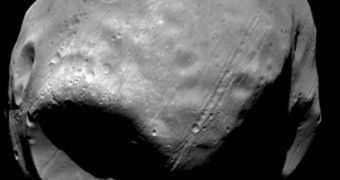Not many people know that Mars has two small moons. And not many astronomers know the reason why these two space bodies exist in orbit around the Red Planet. Now, a debate on their origin brings three competing theories seeking to explain their existence face to face.
The discussion is focused on the Martian moon Phobos, which is the target of a Russian sample-return mission scheduled to lift off this autumn. The object's name means fear in ancient Greek.
When seeking to explain its existence, experts usually turn to one of three, or more recently four, explanations. The fourth is not really taken into account scientifically, because it states Phobos is a 1.5-mile-long ancient spacecraft.
But the other three explanations for the moon's existence make more sense. The first states that the current Martian moon is in fact an asteroid, that was captured by the planet's gravity when it approached too much to the surface.
The second theory says that the diminutive moon formed at the same time Mars did, from the protoplanetary disk around the Sun. In other words, Phobos may have appeared at the same time Mars, Earth, Venus and the other planets were beginning to coalesce into solid objects.
Experts say that the third explanation is that the moon formed after its parent planet did, following a powerful impact by an asteroid or comet. The same type of cosmic event led to the creation of our planet's Moon, astronomers believe.
But the latest studies on the issue appear to indicate that the third explanation of Phobos' existence is the accurate one. The moon is now believed to have formed via orbital coalescing of debris.
The data that led to this conclusion were recently collected by the Mars Express orbiter the European Space Agency (ESA) operated around the Red Planet. The Planetary Fourier Spectrometer (PFS) instrument was used to snap new images of Phobos.
The tool uses thermal infrared wavelengths to make more sense of the objects it analyzes. “We detected for the first time a type of mineral called phyllosilicates on the surface of Phobos, particularly in the areas northeast of Stickney, its largest impact crater,” says Dr Marco Giuranna.
The expert, who is based at the Italian National Institute for Astrophysics (NIA), in Rome, is also the coauthor of a new study detailing the findings.
“This is very intriguing as it implies the interaction of silicate materials with liquid water on the parent body prior to incorporation into Phobos,” the expert adds.
“Alternatively, phyllosilicates may have formed in situ, but this would mean that Phobos required sufficient internal heating to enable liquid water to remain stable,” he concludes, quoted by Daily Galaxy.

 14 DAY TRIAL //
14 DAY TRIAL //